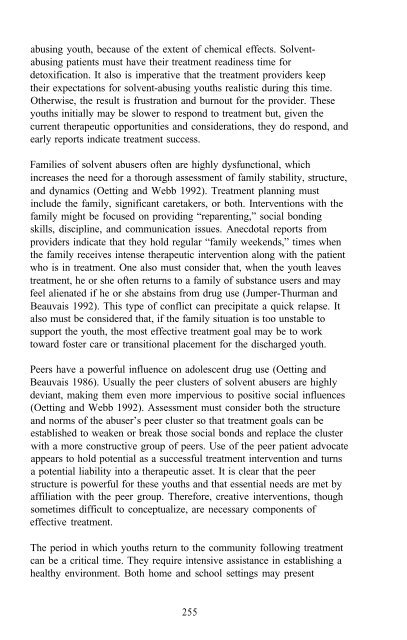Epidemiology of Inhalant Abuse - Archives - National Institute on ...
Epidemiology of Inhalant Abuse - Archives - National Institute on ...
Epidemiology of Inhalant Abuse - Archives - National Institute on ...
Create successful ePaper yourself
Turn your PDF publications into a flip-book with our unique Google optimized e-Paper software.
abusing youth, because <str<strong>on</strong>g>of</str<strong>on</strong>g> the extent <str<strong>on</strong>g>of</str<strong>on</strong>g> chemical effects. Solventabusing<br />
patients must have their treatment readiness time for<br />
detoxificati<strong>on</strong>. It also is imperative that the treatment providers keep<br />
their expectati<strong>on</strong>s for solvent-abusing youths realistic during this time.<br />
Otherwise, the result is frustrati<strong>on</strong> and burnout for the provider. These<br />
youths initially may be slower to resp<strong>on</strong>d to treatment but, given the<br />
current therapeutic opportunities and c<strong>on</strong>siderati<strong>on</strong>s, they do resp<strong>on</strong>d, and<br />
early reports indicate treatment success.<br />
Families <str<strong>on</strong>g>of</str<strong>on</strong>g> solvent abusers <str<strong>on</strong>g>of</str<strong>on</strong>g>ten are highly dysfuncti<strong>on</strong>al, which<br />
increases the need for a thorough assessment <str<strong>on</strong>g>of</str<strong>on</strong>g> family stability, structure,<br />
and dynamics (Oetting and Webb 1992). Treatment planning must<br />
include the family, significant caretakers, or both. Interventi<strong>on</strong>s with the<br />
family might be focused <strong>on</strong> providing “reparenting,” social b<strong>on</strong>ding<br />
skills, discipline, and communicati<strong>on</strong> issues. Anecdotal reports from<br />
providers indicate that they hold regular “family weekends,” times when<br />
the family receives intense therapeutic interventi<strong>on</strong> al<strong>on</strong>g with the patient<br />
who is in treatment. One also must c<strong>on</strong>sider that, when the youth leaves<br />
treatment, he or she <str<strong>on</strong>g>of</str<strong>on</strong>g>ten returns to a family <str<strong>on</strong>g>of</str<strong>on</strong>g> substance users and may<br />
feel alienated if he or she abstains from drug use (Jumper-Thurman and<br />
Beauvais 1992). This type <str<strong>on</strong>g>of</str<strong>on</strong>g> c<strong>on</strong>flict can precipitate a quick relapse. It<br />
also must be c<strong>on</strong>sidered that, if the family situati<strong>on</strong> is too unstable to<br />
support the youth, the most effective treatment goal may be to work<br />
toward foster care or transiti<strong>on</strong>al placement for the discharged youth.<br />
Peers have a powerful influence <strong>on</strong> adolescent drug use (Oetting and<br />
Beauvais 1986). Usually the peer clusters <str<strong>on</strong>g>of</str<strong>on</strong>g> solvent abusers are highly<br />
deviant, making them even more impervious to positive social influences<br />
(Oetting and Webb 1992). Assessment must c<strong>on</strong>sider both the structure<br />
and norms <str<strong>on</strong>g>of</str<strong>on</strong>g> the abuser’s peer cluster so that treatment goals can be<br />
established to weaken or break those social b<strong>on</strong>ds and replace the cluster<br />
with a more c<strong>on</strong>structive group <str<strong>on</strong>g>of</str<strong>on</strong>g> peers. Use <str<strong>on</strong>g>of</str<strong>on</strong>g> the peer patient advocate<br />
appears to hold potential as a successful treatment interventi<strong>on</strong> and turns<br />
a potential liability into a therapeutic asset. It is clear that the peer<br />
structure is powerful for these youths and that essential needs are met by<br />
affiliati<strong>on</strong> with the peer group. Therefore, creative interventi<strong>on</strong>s, though<br />
sometimes difficult to c<strong>on</strong>ceptualize, are necessary comp<strong>on</strong>ents <str<strong>on</strong>g>of</str<strong>on</strong>g><br />
effective treatment.<br />
The period in which youths return to the community following treatment<br />
can be a critical time. They require intensive assistance in establishing a<br />
healthy envir<strong>on</strong>ment. Both home and school settings may present<br />
255
















